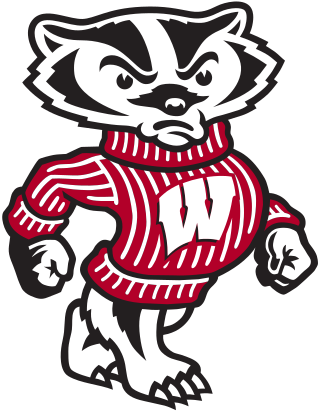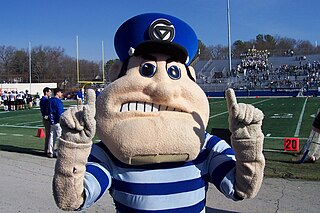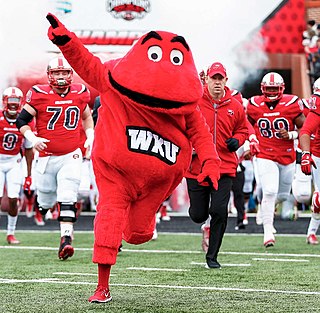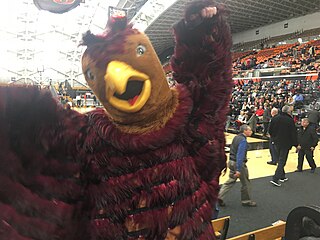
A mascot is any human, animal, or object thought to bring luck, or anything used to represent a group with a common public identity, such as a school, sports team, society, military unit, or brand name. Mascots are also used as fictional, representative spokespeople for consumer products.

A trademark is a word, phrase, or logo that identifies the source of goods or services. Trademark law protects a business' commercial identity or brand by discouraging other businesses from adopting a name or logo that is "confusingly similar" to an existing trademark. The goal is to allow consumers to easily identify the producers of goods and services and avoid confusion.

Benny Beaver is the official mascot of Oregon State University and winner of the 2011 Capital One Mascot of the Year write-in campaign. The exact date of when the name was first used as the university's mascot is not known, but photographs in the school's yearbook document its use as early as the 1940s.

The Swoosh is the logo of American sportswear designer and retailer Nike. Today, it has become one of the most recognizable brand logos in the world, and the most valuable, having a worth of $26 billion alone.

Karachi Grammar School is an independent, English-medium school located in 3 different campuses across Karachi. The main and oldest campus is located in Saddar, Karachi, Sindh, Pakistan. It is a highly selective, coeducational day school serving approximately 2,400 students aged between three and nineteen years.

Buckingham Ulysses "Bucky" Badger is the official mascot of the University of Wisconsin–Madison. The mascot attends major sporting events for the Wisconsin Badgers and other events in Wisconsin.
Neuromarketing is a commercial marketing communication field that applies neuropsychology to market research, studying consumers' sensorimotor, cognitive, and affective responses to marketing stimuli. The potential benefits to marketers include more efficient and effective marketing campaigns and strategies, fewer product and campaign failures, and ultimately the manipulation of the real needs and wants of people to suit the needs and wants of marketing interests.

Louie the Laker is the mascot of Grand Valley State University, located in Allendale, Michigan. The costume of Louie consists of a large cartoonish face with an oversized jaw, a scowl, a blue and white striped shirt, blue pants, a blue captain's hat, and large black boots. He is seen at all football games as well as randomly around campus during events. According to short videos shown at Laker football games, Louie the Laker sleeps on the 50 yard line and dreams of Laker football.
Union Public Schools is a public school district located in southeast Tulsa, and northwest Broken Arrow, Oklahoma. The school district is the eighth-largest in Oklahoma. Union is notable among school districts in the area because Union does not encompass a particular city. Instead, many of its patrons believe Union is a unifying organization within the community, providing activities for its families, a sense of pride, support and identity for its patrons.
The athletic nickname, or equivalently athletic moniker, of a university or college within the United States and Canada is the name officially adopted by that institution for at least the members of its athletic teams. Typically as a matter of engendering school spirit, the institution either officially or unofficially uses this moniker of the institution's athletic teams also as a nickname to refer to people associated with the institution, especially its current students, but also often its alumni, its faculty, and its administration as well. This practice at the university and college tertiary higher-education level has proven so popular that it extended to the high school secondary-education level in the United States and Canada and in recent years even to the primary-education level as well.

The "Jumpman" logo is owned by Nike to promote the Air Jordan brand of basketball sneakers and other sportswear. It is a silhouette of former NBA player and current Charlotte Hornets minority owner Michael Jordan.

Lake Mary High School is a public high school located in Seminole County, Florida, operating under Seminole County Public Schools. It was opened in 1981.

Big Red is the mascot of Western Kentucky University's sports teams, the "Hilltoppers" and "Lady Toppers". It is a red, furry being created by Ralph Carey in 1979. Big Red is meant to symbolize the spirit of WKU students and alumni as well as the sports teams' nickname, the "Hilltoppers," a name chosen because the school's campus sits atop a hill 232 feet above the Barren River flowing through WKU's home city of Bowling Green.

Wentzville Holt High School is the oldest of the four high schools in the Wentzville R-IV School District and second oldest high school in St. Charles County, Missouri. With a 2020-21 enrollment of 1,934, Holt is the largest high school in St. Charles County. Although officially known as Emil E. Holt Senior High School since 1969, it was generally known only as Wentzville High School until 2000, when a renewed emphasis was placed on the "Holt" name in preparation for the addition of a second high school in the district.

The Hawk is the mascot of Saint Joseph's University. The Hawk represents the University's motto, "The Hawk Will Never Die", by flapping its wings non-stop throughout every basketball game. The Hawk, who has been flapping his wings since 1956, is one of the most decorated mascots in college sports, having been called the best college mascot by ESPN College Basketball Magazine, Sports Illustrated, and The Sporting News.

The Seal of Dartmouth College is the official insignia of Dartmouth College, an Ivy League university located in Hanover, New Hampshire, United States. The original seal of Dartmouth College was adopted in 1773, and was engraved by Nathaniel Hurd, who also designed the seal for Harvard College. In 1940, the seal was redone as a line drawing by W. A. Dwiggins, and was further modified in 1957 to correct the founding year of the school from 1770 to 1769. Although Dartmouth College introduced a new logo known as the "D-Pine" in 2018, school officials at the time said that it was not intended to replace the shield.

A trademark is a type of intellectual property consisting of a recognizable sign, design, or expression that identifies a product or service from a particular source and distinguishes it from others. A trademark owner can be an individual, business organization, or any legal entity. A trademark may be located on a package, a label, a voucher, or on the product itself. Trademarks used to identify services are sometimes called service marks.

Texas Tech University traditions are an important part of the culture of Texas Tech University.

Pegasus is the official logo, symbol and mascot of the University of Central Florida (UCF) a metropolitan public research university located in Orlando, Florida, United States.

A Lego clone is a line or brand of children's construction blocks which is mechanically compatible with Lego brand blocks, but is produced by another manufacturer. The blocks were originally patented by The Lego Group in 1961 as "toy building bricks", and the company has since remained dominant in this market. Some competitors have moved to take advantage of Lego brand recognition by advertising their own products as compatible with Lego, with statements such as "compatible with leading building bricks".
















